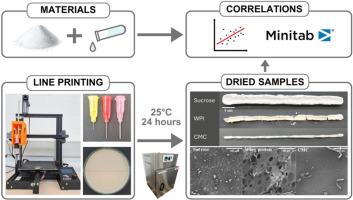选择与食品兼容的打印材料对3D粘合剂喷射产品性能的影响
IF 5.8
2区 农林科学
Q1 ENGINEERING, CHEMICAL
引用次数: 0
摘要
本文研究了三维(3D)食品粘合剂喷射过程中关键性能的动态范围。三维(3D)食品粘合剂喷射是一种选择性地使用液体粘合剂将可食用粉末颗粒粘合在一起的过程。目前,这一领域的研究仍然有限,往往依赖于反复试验和有限的材料范围。因此,该研究提出了一种研究成分-粘合剂组合以优化3d打印食品特性的方法学方法。三种粉末状食品成分(蔗糖、分离乳清蛋白和羧甲基纤维素)分别代表不同的近似食品化学类别,与四种含有水、乙醇、黄原胶和Tween 20的可食用粘合剂溶液结合。进行了系统的调查,以检查这些材料的物理化学特性和由此产生的印刷产品性能之间的关系。研究结果强调,粉末粒度和密度显著影响产品性能,而粘合剂的选择只有在与特定粉末配对时才有实质性的影响。本文章由计算机程序翻译,如有差异,请以英文原文为准。

Effects of selected food-compatible printing materials on product properties towards 3D binder jetting
This study investigates the dynamic ranges of key properties in three-dimensional (3D) food binder jetting, a process in which liquid binder is selectively applied to bind edible powder particles together. Currently, research in this area remains limited, often relying on trial-and-error and a narrow range of materials. Therefore, the research presents a methodological approach for investigating ingredient-binder combinations to optimise the 3D-printed food properties. Three powdered food ingredients (sucrose, whey protein isolate, and carboxymethyl cellulose), each representing different proximate chemical classes of foods, were combined with four edible binder solutions containing water, ethanol, xanthan gum and Tween 20. A systematic investigation was conducted to examine the relationships between the physicochemical characteristics of these materials and the resulting printed product properties. The findings highlight that powder particle size and density significantly affected the product properties, whereas the choice of binder has a substantial impact only when paired with a specific powder.
求助全文
通过发布文献求助,成功后即可免费获取论文全文。
去求助
来源期刊

Journal of Food Engineering
工程技术-工程:化工
CiteScore
11.80
自引率
5.50%
发文量
275
审稿时长
24 days
期刊介绍:
The journal publishes original research and review papers on any subject at the interface between food and engineering, particularly those of relevance to industry, including:
Engineering properties of foods, food physics and physical chemistry; processing, measurement, control, packaging, storage and distribution; engineering aspects of the design and production of novel foods and of food service and catering; design and operation of food processes, plant and equipment; economics of food engineering, including the economics of alternative processes.
Accounts of food engineering achievements are of particular value.
 求助内容:
求助内容: 应助结果提醒方式:
应助结果提醒方式:


